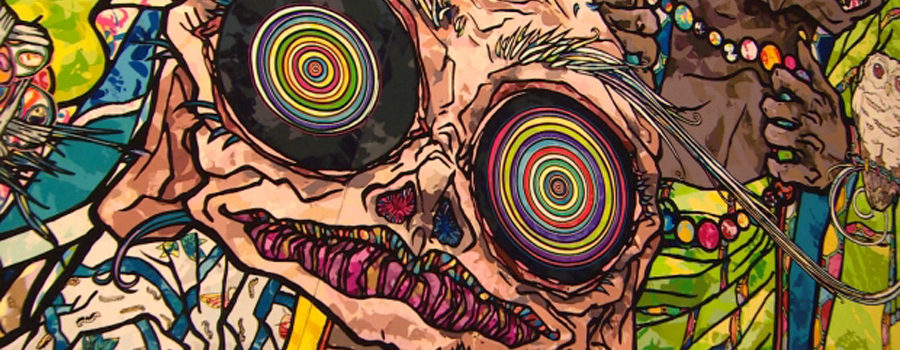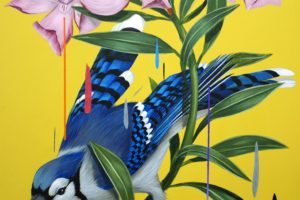August | DESIGN ABSTRACTION
Takashi Murakami: Renaming the “Warhol of Japan”
By Tricia Stewart Shiu
“Sol Poniente” — Dugo
“We want to see the newest things. That is because we want to see the future, even if only momentarily. It is the moment in which, even if we don’t completely understand what we have glimpsed, we are nonetheless touched by it. This is what we have come to call art.” – Takashi Murakami

Takashi Murakami and Pom, his dog – Tokyo. Photo: Fumino Osada
No one likes to be pigeonholed—especially an artist. Yet, it is in our very nature, as humans, to categorize and find similar qualities, for any number of purposes. Many of us are merely trying retain memories or compare and contrast qualities, so we may deepen our understanding of what we observe. Sometimes, our categorization is cultural and other times it is conceptual—such as in the case in delineating art and its creator.
ARTISTIC ALLEGORY | LE MOT JUSTE
Ironically, Takashi Murakami, who, for decades defied categorization, has now reached a level of familiarity, once only reserved for iconoclast, Andy Warhol. In fact, he has been called the, “Warhol of Japan.” Murakami, however, has a different perspective on his status: “Rather than a big figure, I guess you could say, I’m more of an influential minority symbol.”
Murakami—born in 1962—has amassed a multi-dimensional, cross-generational, experiential oeuvre that, somehow, manages to bridge the unspeakable events of Hiroshima with life, as it is today. Viewing his art is, at once, a sparkling display of hope, as well as, an abysmal pit of despair rolled into one. His artistic expression is, unapologetically open about the atrocities that happened to his ancestors and yet, somehow, manages to grab hold of unwavering hope and creates a broader understanding.
“My aesthetic sense was formed at a young age by what surrounded me: the narrow residential spaces of Japan and the mental escapes from those spaces that took the forms of manga and anime.”—Takashi Murakami
According to ArtSpace, “Murakami is truly the heir to Warhol in his ability to appropriate commercial, popular images inspired by anime and manga (Japanese comics) into high-quality pieces of fine art.”
Murakami’s commitment to the expression of artistic presence and timelessness, has been fertile ground for theoretical constructs and social commentary. He even created his own term, Superflat, in which he theorizes, “that the difference in social taste and popular taste have ‘flattened,’ producing a culture with a distinction of high and low.” His continued authentic expression of heart-wrenching grief and fury, interwoven with a global view, contributes to his worldwide demographic-defying draw. Murakami utilizes subcultural and every day elements and translates them into a “high-art” market. He then repackages this “high-art” as affordably priced merchandise. Because of his commercial appeal, his works have been translated onto various other media, ranging from keychains and mugs,” says ArtSpace,“ to a collaboration with French couture powerhouse, Louis Vuitton, which began in 2002.”
 Murakami addresses public concern that, perhaps, those who catch a glimpse of his art may not “get it“ when he says: “even if we don’t completely understand what we have glimpsed, we are nonetheless touched by it.” The beauty, transformative and all-inclusive nature of his art is not in the understanding, but the experience. Perhaps even, the understanding may occur long after someone has visited one of Murakami’s exhibits.
Murakami addresses public concern that, perhaps, those who catch a glimpse of his art may not “get it“ when he says: “even if we don’t completely understand what we have glimpsed, we are nonetheless touched by it.” The beauty, transformative and all-inclusive nature of his art is not in the understanding, but the experience. Perhaps even, the understanding may occur long after someone has visited one of Murakami’s exhibits.
So, the pressure is off of anyone who wishes to explore Murakami’s work. Fair warning: whether immediately or sometime in the future, they will be “touched.“
There is something utterly refreshing about an artist who doesn’t expect you to understand.
By minimizing his own label and calling himself an “influential minority symbol” Murakami calls upon his ancestors who, for centuries painstakingly mastered their craft and passed their learning down from generation to generation. With any hope, the loosening of expectations, however briefly, could potentially bring an end to that heartbreaking, grief-ridden, holistically injured chapter in our world. The beauty is deafening, the echo of souls blinding and the palpable sense of “knowing” sits like a welcoming, just poured a cup of green tea in a china cup.
Take care when you drink, however it may be hot.
“I would like to live to 120, because conceptually, people can survive to 120. Every 20 years, it changes. So maybe, in the next 20 years people can go to space. I don’t know what the next revolution will be. I want to watch.” —Takashi Murakami

“Under the Radiation Falls” – Takashi Murakami in Russia







